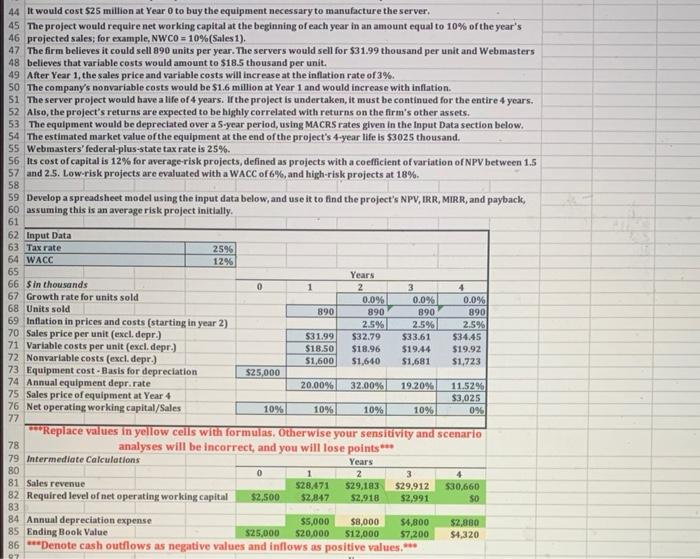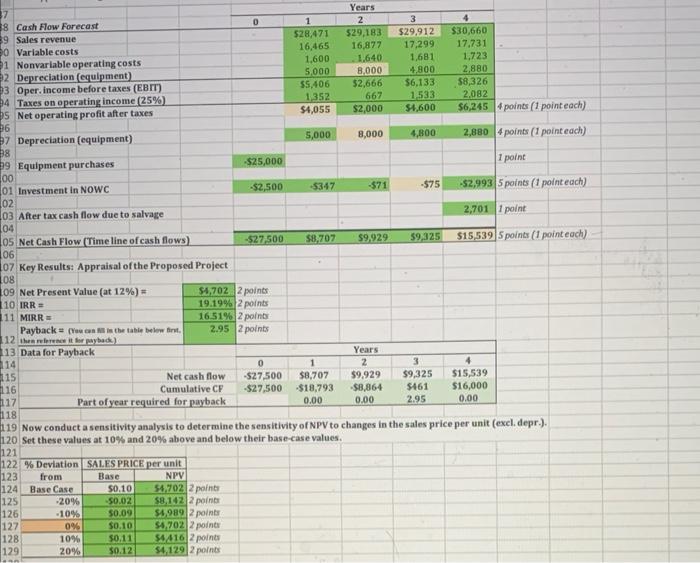It would cost $25 million at Year 0 to buy the equipment necessary to manufacture the server. The project would require net working capital at the beginning of each year in an amount equal to 10% of the year's projected sales; for example, NWCO =10% (Sales 1 ). The firm believes it could sell 890 units per year. The servers would sell for $31.99 thousand per unit and Webmasters believes that variable costs would amount to $18.5 thousand per unit. After Year 1 , the sales price and variable costs will increase at the inflation rate of 3%. The company's nonvariable costs would be $1.6 million at Year 1 and would increase with inflation. The server project would have a life of 4 years. If the project is undertaken, it must he continued for the entire 4 years. Also, the project's returns are expected to be highty correlated with returns on the firm's other assets. The equipment would be depreciated over a 5 -year period, using MACR.S rates given in the input Data section below, The estimated market value of the equipment at the end of the project's 4-year life is 53025 thousand. Webmasters' federal-plus-state tax rate is 25%. Its cost of capital is 12% for average-risk projects, defined as projects with a coefficient of variation of NPV between 1.5 and 25. Low-risk projects are evaluated with a WACC of 6%, and high-risk projects at 18%. Develop a spreadsheet model using the input data below, and use it to find the project's NPV, IRR, MIRR, and paybaclc, Now conduct a sensitivity analysis to determine the sensitivity of NPV to changes in the sales price per unit (excl. depr.). Set these values at 10% and 20% above and below their base-case values. 121 Now conduct a scenario analysis. Assume that there is a 25% probability that best-case conditions, with each of the variables discussed in Part b being 20% better than its base-case value, will occur. There is a 25% probability of worst. case conditions, with the variables 20% worse than base, and a 50% probability of base-case conditions. If the project appears to be more or less risky than an average project, find its risk-adjusted NPV, IRR, and payback. Discussion: On the basis of information in the problem, would you recommend that the project be accepted? We can see from the data above that prior to accepting the project the companies WACC was 12%. After accepting the project the companies WACC jumped a total of 6% to 18%. The 6% higher WACC deary would not be good for the company and shows theres a higherchance of less return once the projected is acepeted. Therefor I would suggest the company not accept this project. It would cost $25 million at Year 0 to buy the equipment necessary to manufacture the server. The project would require net working capital at the beginning of each year in an amount equal to 10% of the year's projected sales; for example, NWCO =10% (Sales 1 ). The firm believes it could sell 890 units per year. The servers would sell for $31.99 thousand per unit and Webmasters believes that variable costs would amount to $18.5 thousand per unit. After Year 1 , the sales price and variable costs will increase at the inflation rate of 3%. The company's nonvariable costs would be $1.6 million at Year 1 and would increase with inflation. The server project would have a life of 4 years. If the project is undertaken, it must he continued for the entire 4 years. Also, the project's returns are expected to be highty correlated with returns on the firm's other assets. The equipment would be depreciated over a 5 -year period, using MACR.S rates given in the input Data section below, The estimated market value of the equipment at the end of the project's 4-year life is 53025 thousand. Webmasters' federal-plus-state tax rate is 25%. Its cost of capital is 12% for average-risk projects, defined as projects with a coefficient of variation of NPV between 1.5 and 25. Low-risk projects are evaluated with a WACC of 6%, and high-risk projects at 18%. Develop a spreadsheet model using the input data below, and use it to find the project's NPV, IRR, MIRR, and paybaclc, Now conduct a sensitivity analysis to determine the sensitivity of NPV to changes in the sales price per unit (excl. depr.). Set these values at 10% and 20% above and below their base-case values. 121 Now conduct a scenario analysis. Assume that there is a 25% probability that best-case conditions, with each of the variables discussed in Part b being 20% better than its base-case value, will occur. There is a 25% probability of worst. case conditions, with the variables 20% worse than base, and a 50% probability of base-case conditions. If the project appears to be more or less risky than an average project, find its risk-adjusted NPV, IRR, and payback. Discussion: On the basis of information in the problem, would you recommend that the project be accepted? We can see from the data above that prior to accepting the project the companies WACC was 12%. After accepting the project the companies WACC jumped a total of 6% to 18%. The 6% higher WACC deary would not be good for the company and shows theres a higherchance of less return once the projected is acepeted. Therefor I would suggest the company not accept this project









